Knights are the trickiest chess pieces in terms of movement. They are very different in that their movement is a bit complex and it has some different rules, but they also don’t have any special moves like pawns or rooks do.
So, how do knights move in chess? Knights move in an L-shape by moving two squares in a horizontal direction, followed by one square in the vertical direction or two squares in a vertical direction and then one square in the horizontal direction, and knights can jump over pieces as well.
For beginners, knights are often the trickiest pieces to get familiar with, but once you get the hang of it, knights are incredible in their tactical abilities.
Let’s look into the movement of knights in chess in more detail so you can take full advantage of them.
How do Knights Move in Chess?
The movement of knights in chess is quite easy. It’s in an L-Shape where the knight can move two squares horizontally or vertically and then one square in the direction perpendicular to the first one.
For example, check out the diagram below:

As you can see, the knight can move in an L-Shape. The movement above is only one of 8 possible moves for this knight. Let’s look now at all possible eight moves.
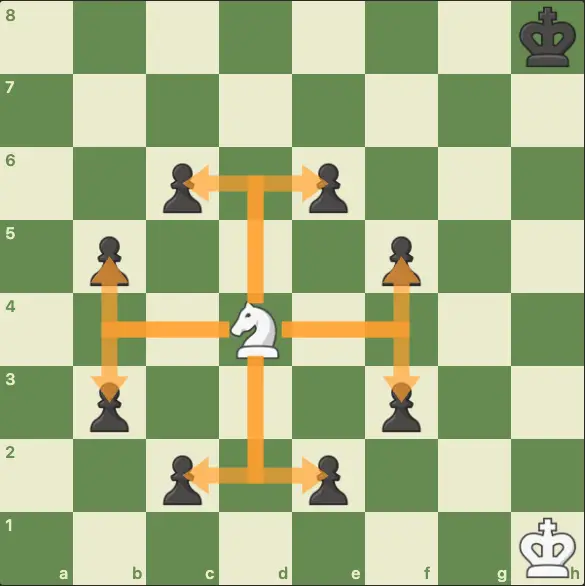
In the diagram above, the knight can take any of the black pawns. The L-shaped arrows show all the possible movements of the knight.
It’s always important to keep in mind all the possibilities of your knights and the possibilities for your opponents’ knights as well.
How do Knights capture other pieces?
Knights capture other pieces by taking them out and taking their squares. If we take the last diagram as an example and assume that the white knight took the e2 pawn, it would look like this:
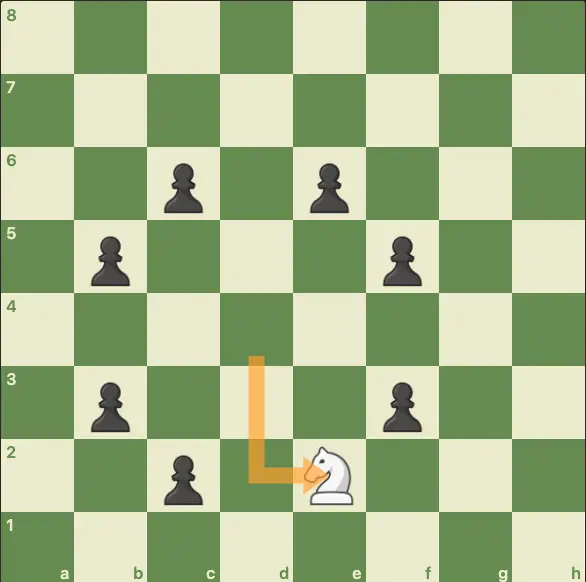
Can Knights jump over other pieces?
Knights can indeed jump over other pieces, regardless of which side these pieces belong to. This means that your knight can hop over your pieces and your opponent’s pieces as well.
A knight can also jump over more than one piece. Knights can move in any direction as long as the square they are targeting is free or occupied by an opponent’s piece.
Why do Knights move in L-shape?
There are many theories amongst chess players as to the origin of the knight’s peculiar move, but the most common one, and the one I think is the closest to being true, is that it is due to the piece’s origin in medieval times.
Chess is ancient, but it has undergone many changes as it moved from India to the Arab world and into Europe.
The current knight is based on the design and movement of the medieval knight, which could move freely in both directions and often did move in an L-shape to outmaneuver their enemies. They could also hop over soldiers and other stuff, so that’s probably where the jumping-over-other-pieces ability comes from.
A knight is the only piece on the chess board that can actually jump over other pieces; no other piece can do that.
Can knights move backward?
Knights can move backward with no problem. All major pieces can move forward and backward on the board.
The only piece that can’t move backward is the pawn, which can only move forward on the same file and can take diagonally, but it can never move backward.
Can two knights checkmate?
Two knights alone with their king can not deliver a checkmate.
This is one of the reasons many chess players believe the knight is inferior to the bishop, which is something we will discuss later in more detail.
However, while two knights can not force a checkmate, a knight and a bishop can checkmate, although it is a very advanced pattern of checkmating and is not easy. I’m not a GM, but I’m not an amateur either, and when I had to perform such a checkmate, I really struggled with it.
Thankfully, my opponent was under time pressure and committed a few errors, which enabled me to corner their king and deliver the checkmate with the bishop.
Can a Knight and Bishop checkmate?
Yes, a knight and bishop can checkmate. In the knight and bishop checkmate, the key to winning is forcing the opponent’s king into the corner that matches your bishop’s color and delivering the checkmate with the bishop.
To do that, you will need not only your knight and bishop but also the help of your king. Similar to what you would do with a checkmate with two bishops.
Why Knights are your best tactical Weapons.
Knights can often deliver decisive blows in complicated situations, but this can only happen if you know the tactical patterns to look for. Due to how they move, knights are great in complicated, tricky, tactical positions where many possibilities exist, and everything is on the line.
Of course, we don’t have enough space in one article for all the tactical patterns you need to know that involve knights, but let’s look at a couple of examples so you can get a better idea of what I’m talking about.
Example 1: The Smothered Mate
The smothered mate is a checkmate that is delivered by the knight in which the opponent’s king is completely tied down by its own pieces surrounding it.
To achieve this, the smothered mate often includes a sacrifice of some kind to bring the last piece to the king’s side before delivering the checkmate.
Let’s look at an example. Check out the position below:

In the position above, there is a forced checkmate in three, and it’s a smothered mate. Here is how it goes:
Nh6+
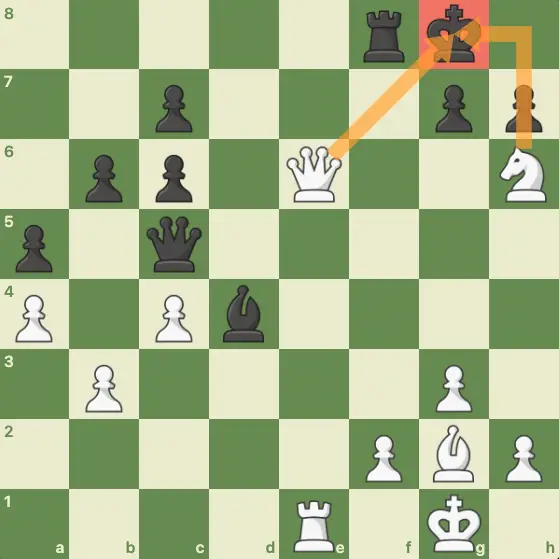
Notice how this is a double-check. It’s a check by the knight on h6, and it’s also a discover check by the Queen on e6. In a double-check like this one, the king can not protect against it and must therefore move.
So, black must play Kh8.
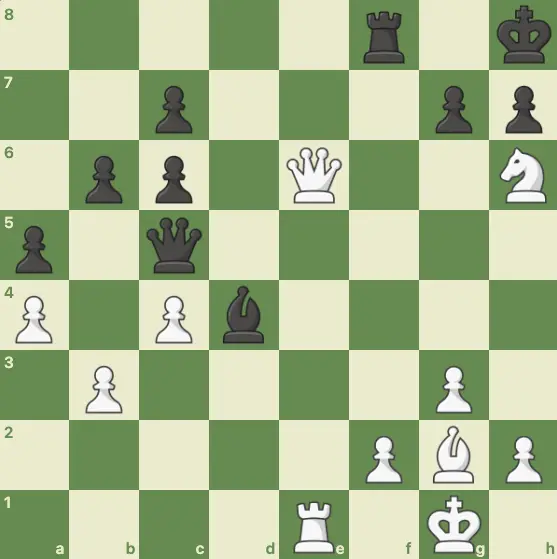
Now, white delivers the killer move with the amazing Qg8+!
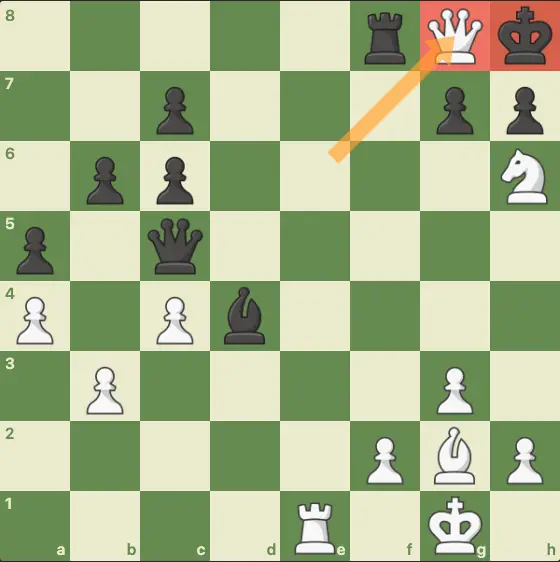
Notice that black can not take with the king, as this is key to the smothered mate. Black must take with a piece, and it’s often a rook or a knight. Here, black must take with the Rook.
So, Rxg8 is forced.
And now white delivers the checkmate with the elegant Nf7#
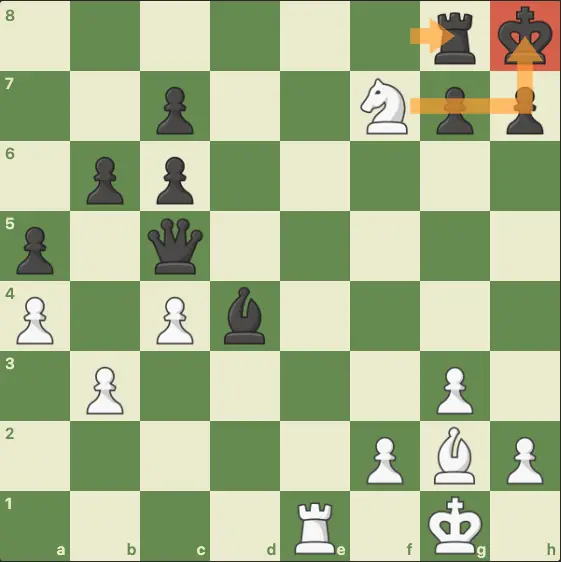
The smothered mate, in my opinion, is one of the most elegant checkmates in chess. It’s forced, simple, and surprisingly common. Definitely one of the mating patterns you must know by heart.
Example 2: The Knight and Rook Checkmate
A knight and a rook are often a powerful pair, but a knight on the 5th rank and a rook on the 7th can turn into a fatal combination very quickly.
Let’s take the position below as an example:

It seems like this is a normal position, but it’s actually winning for white already.
Can you see the winning move for white? If you said Nf7, you are wrong, because the black bishop on b3 is protecting the f7 smothered mate. Nice try though.
The winning move here is Qxf6, essentially winning a piece for free.
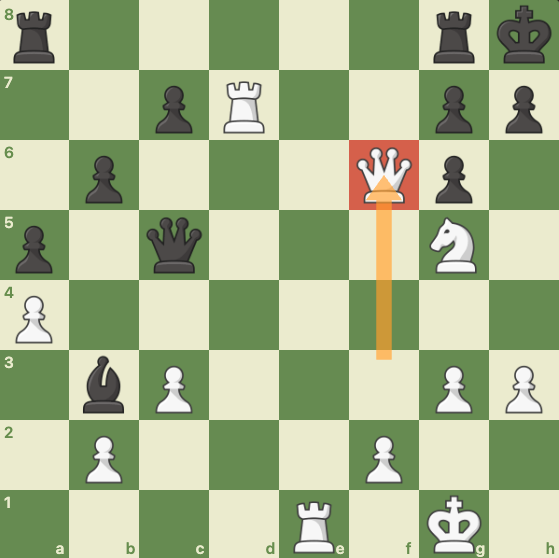
Why is it a free piece? Because black can not take this queen. If gxf6, taking the queen, white delivers the checkmate Rxh7#.
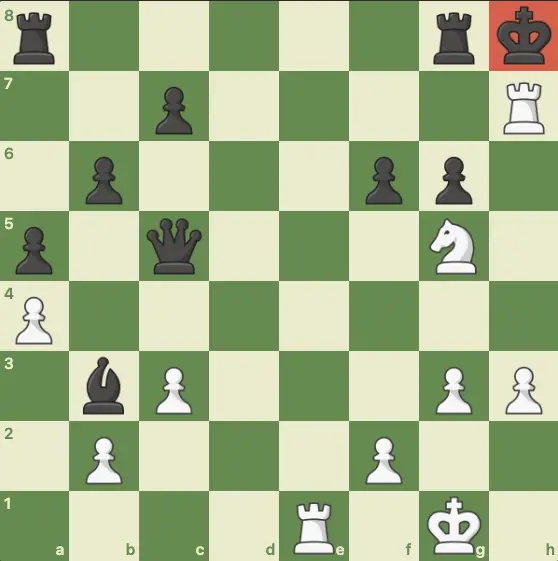
The knight and rook checkmate is another tactical pattern that is very simple to overlook and is surprisingly common, especially in games below the professional levels.
Knights vs. Bishops – which is superior?
Aaah, the age-old question of which is better, the knight or the bishop.
Let’s break it down quickly.
| Comparison | Knight | Bishop |
|---|---|---|
| Movement | L-shaped. Two squares horizontal, one square vertical, or vice versa. | Diagonal. No limit on the number of squares per move. Each bishop can move on squares of one color only (the whole game). |
| Special moves | Can hop over other pieces | None. |
| Can it checkmate alone? | No | No |
| Can two of it checkmate? | No | Yes, with the king’s help. |
| Range | Limited | Unlimited. Can reach the board’s corners and can move from one corner of the board to the other in one move. |
| Favorable positions | Closed positions | Open positions |
| Value | 3 points or 3 pawns | 3 points or 3 pawns. |
As you can see, although knights and bishops have the same value, they are very different pieces. Knights and bishops differ mainly in which position favors them.
For the bishop, which can move as many squares as it wants to (if the path is clear, of course), it can really dominate open positions.
In fact, in knight vs. bishops endgame, the bishop is often the better piece as it can completely restrict the knight’s movement.
Take the position below, for example.
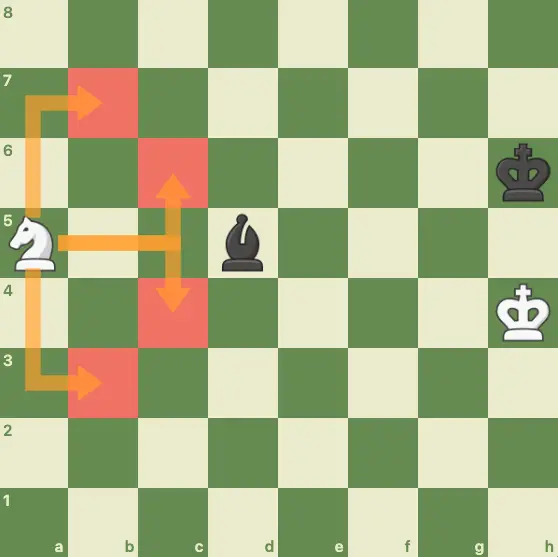
Notice how black’s white-squared bishop on d5 completely dominate the white knight on a5. The white knight can not move and is completely trapped.
The reason this is possible is because the way the knight moves makes it so that all the squares the knight can jump into at any move are all the same color which is the opposite color to the square the knight is currently occupying.
So, in the position above, because the knight is on the black a5 square, all the squares available to it are white, and the black bishop on d5 is in the perfect spot to control all of those squares and trap the knight in place.
A fairly common trick in knight vs. bishop endgames is to lure the knight to the last row or rank with a free pawn, so the side with the bishop essentially sacrifices the pawn in exchange for taking the knight out of the game for as many moves as possible.
Now, let’s look at an example where the knight is superior to the bishop.
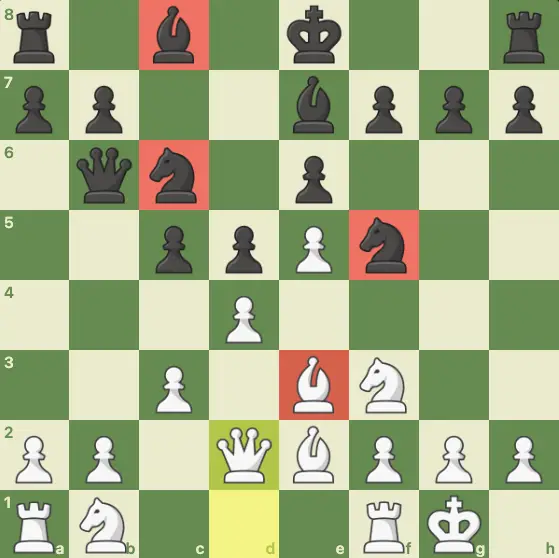
The position shown in the diagram above is a fairly common position that arises from the advanced variation in French Defense.
Notice how in this position, the knights are the active pieces for both sides. The black knights on c6 and h5 are exerting pressure on white’s pawn chain at the d4 square, with white’s knight at f3 participating in the defense. White can also bring in the other knight with the maneuver Na3 and then Nc2.
On the other hand, look at the bishops on both sides. The white bishop on e3 is basically playing the part of a pawn protecting the d4 pawn, and the black’s white-squred bishop on c8 is worthless.
Black’s white-squared bishop is actually the largest problem black has in the french defense, thanks to its pawn structure being mostly on white squares and restricting its movements.
Conclusion
Knights are strong but tricky pieces. They move in an L-shape, which gives them limited range and makes them susceptible to entrapment by bishops, but they are perfect in closed positions crowded by pieces of both sides since they can hop over other pieces and exert pressure at multiple points simultaneously.
In closed positions, you should never exchange your knights for bishops and should instead try to activate your knights by hopping them around to the best spot. However, if you are going into a fairly simple endgame, a bishop is often more powerful than the knight, so you should try to exchange your knights for your opponent’s bishops.
To make the best out of your knight, you should also learn the patterns that involve your knight, like the smothered mate discussed here.
Knights FAQs
Can knights hop over two pieces?
Knights can hop over two pieces, and there are no rules on chess that specify what number or type of pieces knights can hop over, so the knight can hop over any pieces as long as the square they are targeting is vacant or occupied by an opponent’s piece.
How many pieces can a knight jump over?
There are no rules in chess that specify a certain number of pieces a knight can hop over, neither in one move nor in the whole game, so your knights are free to hop over all the pieces they want as long as they move in an L-shape, and the square they will end up in is vacant or occupied by an opponent’s piece they can capture.
Can a Knight take a king?
A knight cannot capture a king as this would be illegal. No piece, including the mighty knight, can capture a king, but any piece (except for the other side’s king) can checkmate the king.
Can a Knight jump over a king?
Knights can jump over kings, whether that’s their side’s king or the opponent’s. However, a knight may not capture a king and take its square.
Can a knight jump over a queen?
Knights can jump over queens, and there is no piece that the knight can not hop over.
